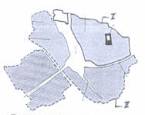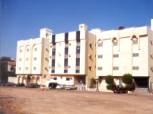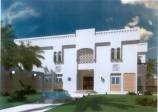|
1-5 Types of Housing Units: Housing types of
Al-Madina could be figured through two main eras, the old era when the
whole city was circulated by fences. The second era began after the
demolishing of these walls and continues to the present. 1-5-1) The
First Era: Al-Madina Al-Monawarah was distinguished with the multiple
open areas with different sizes; the most important of which a large
square named Al-Manakha, which split the city into two (Figure 4). Al-Madina
Al-Monawarah combines in its traditional urban structure between two
types, one of them is the alley style that is popular in most Islamic
cities, and the second is the courtyard style that distinguishes its
urban style. The difference between the two types is that the alley
type consists of a main street called “Hara” with many side
roads where houses are lined on both sides, while the court yard type
consists of a main street similar to the alley, but with many openings
that are actually gates leading to an open area surrounded by houses
from all sides (Figure 5). Such courtyard had a very important role
in Al-Madina Al-Monawarah’s urban fabric through relieving the
crowdness of the buildings that was a common style in Moslem cities(5).



|
It
is noticed, from the above, the different relationship between the percentage
of each housing model with the development of the social and income
structures, that is evident from the large fall or decrease of the traditional
housing type, against the increase in the villas and buildings. In additional
to the difference in the percentage of increase of each type, largely
favoring the villa’s type. Private houses and clusters of houses are the determining components of the urban fabric in Moslem cities, not only because of their sheer quantitative dominance but also because of their particular attitude of Islam towards formal civil institutions and its relatively low emphasis on monumental public building. It therefore seems appropriate to start the discussion of the Islamic structure with the analysis of the residential unit. In examining a place like a house within the urban context of Al-Madina, two major factors should be considered: the impact of the environment and the relationships between the design of the house and cultural influences. Figure (9) summarizes this approach. It portrays the house as a reflection of several facets of culture and as a place that has many “windows” through which one can see how a culture relates to it’s environment. (9) |
||||||||||||||
| << Prev. | |||||||||||||||


